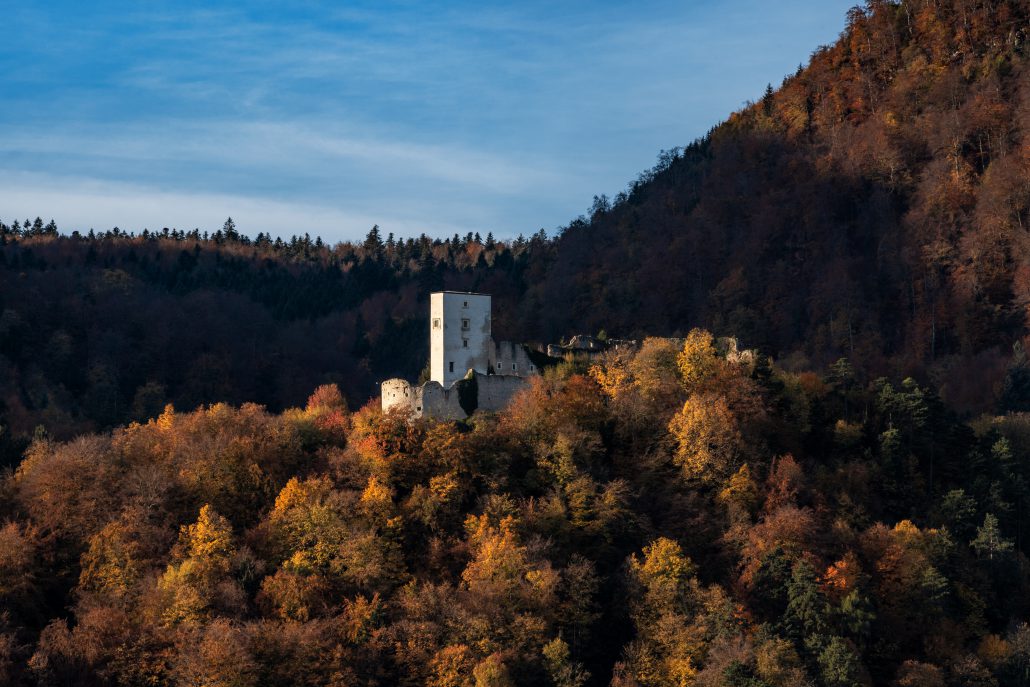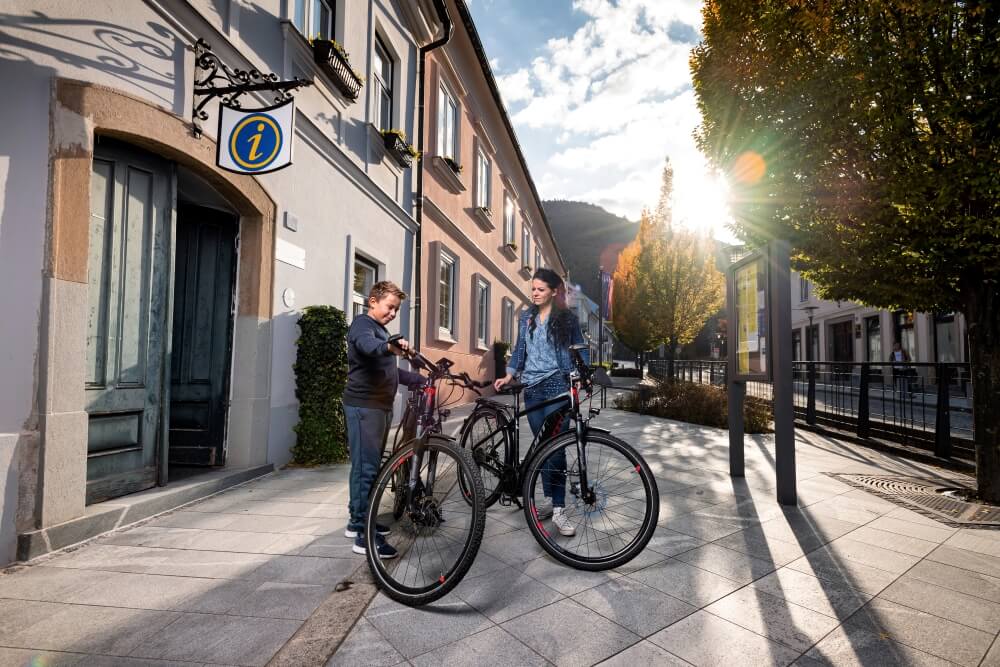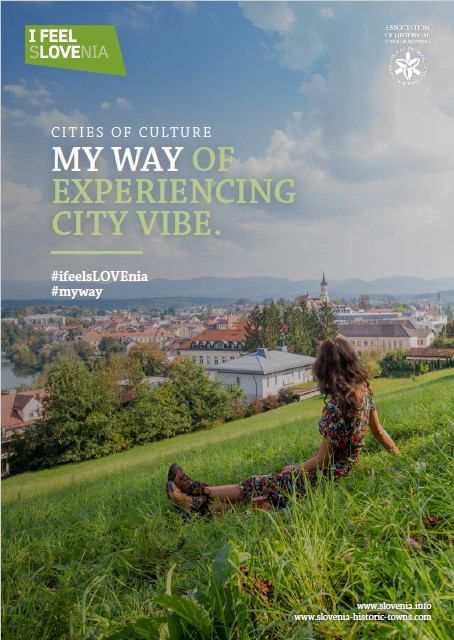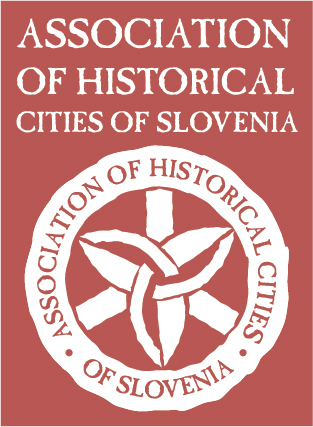In Minatti's footsteps
Follow in Minatti's footsteps. Discover the town associated with horses. Take a walk along the stream that flows right through the central Mestni trg.
To a town with a horse in the coat-of-arms
Start your visit of Slovenske Konjice at the bus station, where there is also a free of charge parking lot. Near the station is the information board with a town map. From here, head for the old squares. Start at Mestni trg square, where you are greeted by the Woman on Horseback statute (1). Among other things, the House of Culture and the once popular, now closed Dravinja Hotel are found here.
Behind the hotel, the Dravinja Rivers separates the old and the new part of the town. A bridge, guarded by statues of four horses, connecst both river banks. Let’s stop and listen to the sounds of water and nature. There are not many places in the world where such moments are available in the town centre itself.
A Tip: You can prepare for the hike by treating yourself to a scoop of ice cream from the Mali Čoko ice cream parlour or coffee at Central Caffe bar close to the town information board.
Across the bridge to Minatti 's birth house
Walk across the bridge. On the left, there is a new market with a shop of local delicacies. Opposite the market is a statue of the Fountain for Two Birds (2). On the right is a wooden monument indicating that the town has twice won the European Entente Florale competition (3). Continue straight on between the two rows of houses. This is where Stari trg square begins. The path on the right leads you to a house with a guild sign (4), which testifies to the once flourishing leather craft in the city. Across the street is the only two-story house on the square – the seat of former district authority (5). Nearby is the house no. 9 – the birth house of the poet Ivan Minatti (6). There is a flower shop in the house today, but there used to be a post office once. At the time of the poet’s birth, the Minatti family lived in an upstairs apartment.
A Tip: Stop at the Beli Konj pub, where they serve probably the best coffee in town, and the pub also boasts a real Ice Cream Lane.
To the house of the poet's childhood under the wine-growing hills
When you turn your back to the house no. 9, notice how the line of compact market houses is broken. Once upon a time, all the traffic took place here and there was an important road junction here. We arrive at Celjska cesta road among the old market houses, where there are two banks and a craftsmen centre. A few minutes walk separates us from the house no. 10 with a memorial plaque. It reads that this is the birth house of Ivan Minatti. Today we know that it is the house of his childhood (7). From here he observed the “white house in the middle of Škalce hills” several times. If you removed the treetops, you could also see this white house by now – the now renovated Vinogradniški dvorec (Vineyard manor) on top of Škalce.
A Tip: From here, the Zlati grič Wine Cellar is a 10-minute walk away. In the cellar they present, among other things, Konjičan wine, which you can otherwise taste in every local inn, in an authentic way. An additional 5-minute walk uphill brings you to Gostilna Grič inn, famous for its excellent cuisine and views of the golf course among the vineyards.
To the poet's father workplace
From the house we return back to the crossroads and turn right, continue uphill to the next crossroads, where we see St. George’s Church (8). To its right is the imposing building of the former school, built in 1868. Behind the church is a parking lot, which offers a magnificent view of the Old Castle (9) on Konjiška gora. To the left of the parking lot is a gate which brings you to the church and to the point from where you can see the houses of Stari trg square. Among them we find a house with a fresco of St. Florian (10). There used to be a surveying office here, where Ivan Minatti’s father did his daily work.
Stari trg square and Minatti's coffee
Head back to Stari trg square. Go past the yellow building with the image of a bee testifying that there used to be a savings bank here (11). Cross one of the short bridges over a stream of different names (12). Accompanied by the murmur of water, walk to the municipality building and the Tourist Information Centre (13) in the adjacent building. On the way across the square, observe its medieval design. The houses of craftsmen and merchants have beautiful facades and courtyards facing the square with craft tracts and gardens. Attention is drawn to the house with the painting of the Holy Family (14) and a closed inner courtyard. Before continuing on, treat yourself to unique, fragrant Minatti coffee, which also includes reading poetry.
A Tip: Minatti coffee is served at the Tattenbach pub. With a cup of coffee, you get a paper roll from which you can read one of Minatti’s songs or the winning song of the Minatti Song of the Year contest.
Among the saints of the stone city
When you stop at Stari trg square, above the stream you will definitely notice the plague column of St. Florian (15) with four saints, which, among other things, is reminiscent of frequent fires in the town. Present-day character of the town dates back to the time when the last major fire caused rebuilding of the town houses using stone from the Žiče Charterhouse (16). The originals of the statues, the replicas of which we admire in the square, are safely stored in the Riemer Town Gallery (17). By arrangement at the Tourist Information Center (14), you can see the works of world-famous foreign and domestic painters in the gallery.
A Tip: If you need refreshments, continue downhill and turn left at the crossroads near Minatti’s birth house. Center okusov is offering modern fast food. A little further on is the Strnad bakery, where you can also choose a Pohorje slice.
Across the green patches to the poet's bench
Walk back to Mestni trg square. At the statue of Woman on Horse (1), direct youurself to the path between the House of Culture and the District Court. The path takes you to a children’s village with wooden houses and to the outdoor fitness equipment called Zelen’ plac (18). After a green break, continue your way to the main road. Turn left and cross the road at the second traffic light. Here is a formidable composition of Konjičan train( 19), which once puffed along the narrow-gauge track. Before the locomotive, turn right and cross the road again. There is a bronze statue of Ivan Minatti (20) on a marble bench beneath the birch trees just before the News & Radio Rogla building. In the lobby of the media house is the Minatti’s book exchange (21). Here you can be readers in the poet’s company.
From here you are only a good 200 meters walk away from the bus station, the starting point of your route.
Suggestions for a hike
To Konjiška gora
From the edge of the town, head to Konjiška gora with several peaks. Follow the marked paths to Skala (702 m) with an arranged lookout point and to Stolpnik (1021 m) with a 25 m high lookout tower. For a family hike, choose the Little Dragon’s Forest Learning Path, which starts at the Pod gora Primary School, near St. George’s Church. A 3-kilometer long route with 12 content points brings you to the Old Castle, to the Konjska smrt gorge and to Trebnik Mansion with a park and play equipment for children.
On the remains of the Old Castle with a Romanesque core and Gothic walls, there is a platform with a beautiful view of Slovenske Konjice. The Konjska smrt gorge is a narrow ravine that allowed the shortest passage over the mountain, but was too demanding for horses. Trebnik Mansion is famous for its natural products with herbs, the park with mighty trees, a pond and an obstacle course.
More information: TIC Slovenske Konjice

Woman on horse
Osrednjo ploščad Mestnega trga, obdanega s stavbami, kot so sodišče, Dom kulture in Hotel Dravinja, od leta 2009 bogati zanimiva trimetrska skulptura konja z žensko na hrbtu. Umetniško delo je mestu podaril njegov avtor, akademski slikar in kipar Vasilij Četkovič – Vasko. Slovenske Konjice imajo konja v svojem grbu že do 16. stoletja.
Mestni trg
2. Fountain for two birds
The fountain of the academic sculptor Franc Purg, which originally stood on Mestni trg square, got its permanent place on Stari trg square, opposite the new market, after the renovation in 2013. After renovation, the statue, created in 1987 as an illustration of the symbols of life and freedom, is mainly associated with water, which is present everywhere in the centre of Slovenske Konjice. The fountain, which now stands at the meeting point of Mestni and Stari trg squares near the Dravinja River, illustrates the circular flow of life, a smaller and a larger bird.
Stari trg
3. Entente Florale
The wooden monument draws attention to Slovenske Konjice as one of the best-kept towns in Europe. Several awards for the most beautiful town destination are complemented by two gold medals from the European Entente Florale competition. Judges from several European countries assess the orderliness of cities according to the criteria of sustainable environment, ecological awareness and coexistence with the authentic natural environment, as well as natural and cultural heritage.
Stari trg
4. Guild sign
The restored guild sign on Stari trg square is reminiscent of the flourishing leather industry in Slovenske Konjice. Local tanners were especially important to the town in the 18th and 19th centuries. In the 20th century, an important Konus leather factory operated in the town.
Stari trg
5. Former district authority,
The house, which is one floor higher than the other houses on Stari trg, was called the District Authority until 1941, and during the Second World War it was the official premises of the mayor. The house still has an unchanged exterior today.
Stari trg 5
6. The birth house of the poet Ivan Minatti
Ivan Minatti, an important representative of the post-war generation of Slovene poets, was born on 22 March 1924 in Slovenske Konjice. His family moved to Slovenj Gradec in 1929 and then to Ljubljana, and Ivan Minatti liked to return to his native Slovenske Konjice in his mature years. He was an expert on Slavic languages by profession. He worked as an editor, translator and academic. Many of his songs, especially the one called You Have to Love Someone, are so well known among Slovenes that they have almost become national.
Stari trg 9
7. The house of the poet's childhood
A memorial plaque on the house indicates that Ivan Minatti was born here. In fact, he was born in a house in the Old Square, and spent the years of his childhood here. During frequent visits to Slovenske Konjice in the late years of his life, Ivan Minatti liked to remember how he played in the garden behind the house. From the garden he could see “the white house in the middle of Škalce”, which imprinted in his memory forever.
Celjska cesta 10
8. St. George's church
The oldest part of the present church is the main nave, which was built in the 12th or 13th century. The bell tower dates from the end of the 13th century and ranks among the oldest and largest in Štajersko with its mighty architecture. The late Gothic building preserves a large altar with a statue of St. George from 1869, and larger-than-life sculptures from the previous Baroque altar are placed along the walls of the presbytery, depicting the apostles: St. Peter, St. Paul, St. Hieronymus and St. John the Baptist. In the side nave, the so-called “old church,” stands the marble altar of the Holy Cross.
9. Old castle on Konjiška gora
The castle, probably built as early as the 10th century, was one of the largest and most imposing in Štajerska. The original Romanesque core of the castle is barely visible today. In the western part of the ruins we still come across Romanesque walls. Romanesque is also a small tower in the middle of the ruins. Most of the walls date back to the Gothic period. This includes in particular the mighty five-pointed tower, which was attached to a residential building in the 14th century, as well as a massive defensive wall rim. Later, the perimeter was fortified with a belt of Renaissance fortifications – among them a bastion with almost four-meter walls. The first known owners of the castle were the Lords of Konjice. The first mentioned was Liupold I. in 1164.
10. Fresco of st. Florian
A distinctly long storey building stands in an interrupted market line. There are Renaissance window sills on the façade. On the west façade, in a white frame, is a fresco of St. Florian, which probably dates from the time after the fire in 1600. The building got its present appearance in the first half of the 19th century. The entrance portal with the year 1833 shows all the characteristics of this period. The frames are decorated with motifs of scales and a tassel, the windows have narrow bar-shaped edgings and strongly protruding shelves. The building once housed a surveying office, where Ivan Minatti’s father worked, and little Ivan visited him several times. Through the window he watched the church and the bell tower.
Stari trg 39
11. Savings bank
The large, corner building was built in the Art Nouveau style in the early 20th century (the hall floor bears the year 1904). Façade surfaces are adorned with a typical Art Nouveau finish. The house is a good representative of Art Nouveau in Slovenia. The building with a bee on top used to be home to a savings bank. Today, it houses the Employment Service Office.
Stari trg 36
12. The Ribnica stream
The stream, which gives a special charm to Stari trg square, has as many as four names, but it is officially called the Ribnica. The name is said to be associated with two ponds that were once near the Trebnik mansion. The locals know the stream under the names Dragon’s Blood or Dragon’s Slobber. This name is associated with the legend that St. George cut the head off of a dragon that lived in Konjiška gora. The fourth name for the stream is Miss, which is also the name of the source of the stream behind the Old Castle. The name is associated with the legend of a castle lady who allegedly drank ice-cold water and died from the cold at the spring.
13. Slovenske Konjice Tourist Information Centre
TIC is housed in a restored narrow building with a 19th-century street façade. It houses a local souvenir shop and a rental of e-bikes. Here you can get all tourist information regarding Slovenske Konjice and Rogla-Pohorje destination.
Stari trg 27, T: 03 759 31 10
14. A house with a painting of the Holy family
The tall building stands in a closed row of houses. The street façade includes Neo-Renaissance elements of the second half of the 19th century. On the ground floor, there are preserved gates, which have rich, carved applications with Renaissance motifs. In the middle axis, on the first floor, is a painting of the Holy Family from 1893.
Stari trg 22
15. The plague column of St. Florian
The central pillar of the plage column bears the statue of St. Florian. On the lower pedestals around it are the statues of St. Francis Xavier, St. Roch, St. George and St. John of Nepomuk. The column reminds of times of frequent fires in the past. The town burned to the ground at least four times. The plague column was erected by the famous equestrian sculptor Franc Zamli in the 18th century.
Stari trg
16. Žiče Charterhouse
Many buildings in Slovenske konjice are built from stones of the Žiče Charterhouse. This mighty monastery of white monks was built in the remote Valley of St. John the Baptist in the early 12th century. The oldest Carthusian monastery in Central Europe and the first outside the native French and Italian Carthusian area was one of the most important European monasteries in the Middle Ages. After its closure, a part of the buildings was demolished in the 18th century, and the material was used to rebuild the fire-damaged Slovenske Konjice.
17. Riemer Town gallery
The gallery is located in a restored town house with a beautiful Renaissance arcaded corridor. The permanent collection displays paintings from the early Renaissance to the present day. The oldest painting dates from the 15th century while the most precious is the painting of the Venetian school of Leonardo da Vinci. The gallery is also adorned with works by Cezanne, Klimt, Rodin, Modigliani, Velasquez. Here are also self-portraits of Ivana Kobilica and Tisnikar, drawings by Rihard Jakopič and a fresco, found in Žiče Charterhouse. The gallery is enriched by a collection of antique furniture, including a writing desk with a hidden drawer, which was once owned by the Slovenian poet Oton Župančič.
Stari trg 15
18. Zelen' plac
The green urban space of Slovenske Konjice has enriched the park areas of the town with playful houses for children and outdoor gym equipment. Zelen ‘plac is a venue for reading hours and other events that encourage intergenerational cooperation and socializing.
19. The Konjičan train
In 1892, Slovenske Konjice got a railway line that connected them with Poljčane. In 1921, the line was extended to Zreče. The narrow-gauge railway operated until 1963, and in 1970 its tracks were removed. At a good 20 kilometers, the line had 9 stations, and crossed 3 bridges. The museum’s steam locomotive with a few wagons, placed on the site of a former railway station, is reminiscent of railway days.
20. The statue of Ivan Minatti
The first statue of Ivan Minatti was erected in Slovenske Konjice in 2015. The bronze statue is the work of academic sculptor Katja Majer, and seated on a bench made with indigenous Pohorje granite. The monument is the venue of public readings of poetry on poet’s birthday, 22nd March, organized by the News & Radio Rogla media company. The statue is placed in front of the headquarters of the media house, which also organizes the Minatti Song of the Year competition.
Škalska cesta 7
21. Minatti 's book exchange
Slovenske Konjice is a reading-friendly municipality. This is also proven by the town’s largest book exchange – a place where anyone can hand in or take a used book. Minatti’s book exchange can be found in the lobby of the News & Radio Rogla media house.
Škalska cesta 7
- 1Woman on horse
- 22. Fountain for two birds
- 33. Entente Florale
- 44. Guild sign
- 55. Former district authority,
- 66. The birth house of the poet Ivan Minatti
- 77. The house of the poet's childhood
- 88. St. George's church
- 99. Old castle on Konjiška gora
- 1010. Fresco of st. Florian
- 1111. Savings bank
- 1212. The Ribnica stream
- 1313. Slovenske Konjice Tourist Information Centre
- 1414. A house with a painting of the Holy family
- 1515. The plague column of St. Florian
- 1616. Žiče Charterhouse
- 1717. Riemer Town gallery
- 1818. Zelen' plac
- 1919. The Konjičan train
- 2020. The statue of Ivan Minatti
- 2121. Minatti 's book exchange





